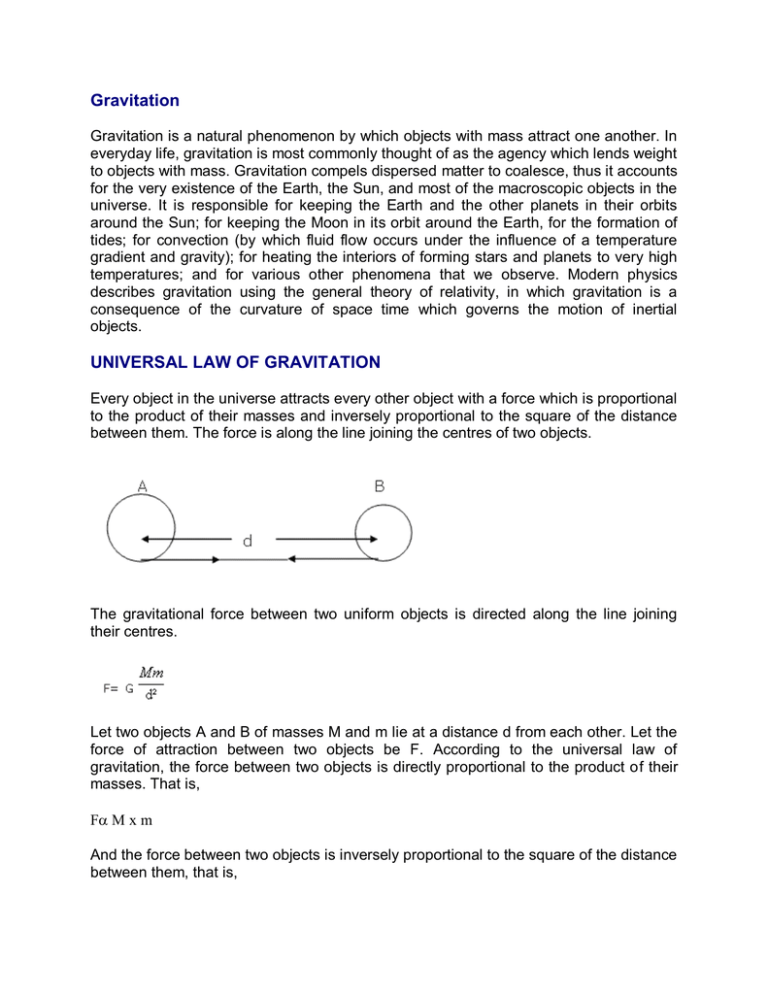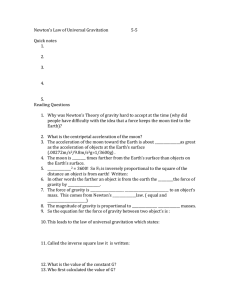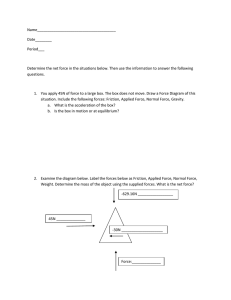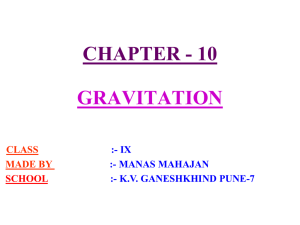Gravitation UNIVERSAL LAW OF GRAVITATION
advertisement

Gravitation Gravitation is a natural phenomenon by which objects with mass attract one another. In everyday life, gravitation is most commonly thought of as the agency which lends weight to objects with mass. Gravitation compels dispersed matter to coalesce, thus it accounts for the very existence of the Earth, the Sun, and most of the macroscopic objects in the universe. It is responsible for keeping the Earth and the other planets in their orbits around the Sun; for keeping the Moon in its orbit around the Earth, for the formation of tides; for convection (by which fluid flow occurs under the influence of a temperature gradient and gravity); for heating the interiors of forming stars and planets to very high temperatures; and for various other phenomena that we observe. Modern physics describes gravitation using the general theory of relativity, in which gravitation is a consequence of the curvature of space time which governs the motion of inertial objects. UNIVERSAL LAW OF GRAVITATION Every object in the universe attracts every other object with a force which is proportional to the product of their masses and inversely proportional to the square of the distance between them. The force is along the line joining the centres of two objects. The gravitational force between two uniform objects is directed along the line joining their centres. Let two objects A and B of masses M and m lie at a distance d from each other. Let the force of attraction between two objects be F. According to the universal law of gravitation, the force between two objects is directly proportional to the product of their masses. That is, F M x m And the force between two objects is inversely proportional to the square of the distance between them, that is, Combining the Eqs. we get Where G is the constant of proportionality and is called the universal gravitation constant. By multiplying crosswise, Eq. gives F × d2 = G M × m The SI unit of G can be obtained by substituting the units of force, distance and mass in Eq. as N m2 kg–2. The value of G was found out by Henry Cavendish (1731 – 1810) by using a sensitive balance. The accepted value of G is 6.673 × 10 –11N m2 kg–2. Example: The mass of the earth is 6 × 10 24 kg and that of the moon is 7.4 × 10 22 kg. If the distance between the earth and the moon is 3.84×10 5 km, calculate the force exerted by the earth on the moon. G = 6.7 × 10–11 N m2 kg-2 Solution: The mass of the earth, M = 6 × 1024 kg The mass of the moon, m = 7.4 × 1022 kg The distance between the earth and the moon, d = 3.84 × 105 km = 3.84 × 105 × 1000 m = 3.84 × 108 m G = 6.7 × 10–11 N m2 kg–2 From Eq. the force exerted by the earth on the moon is = 2.01 × 1020 N Thus, the force exerted by the earth on the moon is 2.01 × 10 20 N. IMPORTANCE OF THE UNIVERSAL LAW OF GRAVITATION The universal law of gravitation successfully explained several phenomena which were believed to be unconnected: (i) the force that binds us to the earth; (ii) the motion of the moon around the earth; (iii) the motion of planets around the Sun; and (iv) the tides due to the moon and the Sun. TO CALCULATE THE VALUE OF g To calculate the value of g, we should put the values of G, M and R in Eq. namely, universal gravitational constant, G = 6.7 × 10–11 N m2 kg-2, mass of the earth, M = 6 × 1024 kg, and radius of the earth, R = 6.4 × 106 m. = 9.8 ms-2 Thus, the value of acceleration due to gravity of the earth, g= 9.8 ms-2 MOTION OF OBJECTS UNDER THE INFLUENCE OF GRAVITATIONAL FORCE OF THE EARTH We know that an object experiences acceleration during free fall. From Eq. this acceleration experienced by an object is independent of its mass. This means that all objects hollow or solid, big or small, should fall at the same rate. According to a story, Galileo dropped different objects from the top of the Leaning Tower of Pisa in Italy to prove the same. As g is constant near the earth, all the equations for the uniformly accelerated motion of objects become valid with acceleration a replaced by g The equations are: v = u + at S= ut + ½ at2 v2 = u2 + 2as Where u and v are the initial and final velocities and s is the distance covered in time, t. In applying these equations, we will take acceleration, a to be positive when it is in the direction of the velocity, that is, in the direction of motion. The acceleration, a will be taken as negative when it opposes the motion. Example: A car falls off a ledge and drops to the ground in 0.5 s. Let g = 10 m s–2 (for simplifying the calculations). (i) What is its speed on striking the ground? (ii) What is its average speed during the 0.5 s? (iii) How high is the ledge from the ground? Solution: Time, t = ½ second Initial velocity, u = 0 m s–1 Acceleration due to gravity, g = 10 m s–2 Acceleration of the car, a = + 10 m s–2 (i) speed v = a t v = 10 m s–2 × 0.5 s = 5 m s–1 (ii) average speed = (0 m s–1+ 5 m s–1)/2 = 2.5 m s–1 (iii) distance traveled, s = ½ a t2 = ½ × 10 m s–2 × (0.5 s) 2 = ½ × 10 m s–2 × 0.25 s2 = 1.25 m Thus, (i) Its speed on striking the ground = 5 m s –1 (ii) Its average speed during the 0.5 s = 2.5 m s –1 (iii) Height of the ledge from the ground = 1.25 m. Example: An object is thrown vertically upwards and rises to a height of 10 m. Calculate (i) the velocity with which the object was thrown upwards and (ii) the time taken by the object to reach the highest point. Solution: Distance traveled, s = 10 m Final velocity, v = 0 m s–1 Acceleration due to gravity, g = 9.8 m s–2 Acceleration of the object, a = –9.8 m s–2 (i) v2 = u2 + 2a s 0 = u2 + 2 × (–9.8 m s–2) × 10 m –u2 = –2 × 9.8 × 10 m2 s–2 u= m s-1 u = 14 m s-1 (ii) v = u + a t 0 = 14 m s–1 – 9.8 m s–2 × t t = 1.43 s. Thus, (i) Initial velocity, u = 14 m s–1, and (ii) Time taken, t = 1.43 s. Mass:- mass refers to the degree of acceleration a body acquires when subject to a force: bodies with greater mass are accelerated less by the same force. Weight:- Weight is the force of gravity acting on a mass. Weight should be measured in Newtons and has a direction component (vector). This direction is normally downward due to gravity. We know that the earth attracts every object with a certain force and this force depends on the mass (m) of the object and the acceleration due to the gravity (g). The weight of an object is the force with which it is attracted towards the earth. We know that F = m × a, that is, F = m × g. The force of attraction of the earth on an object is known as the weight of the object. It is denoted by W. W=m×g WEIGHT OF AN OBJECT ON THE MOON The weight of an object on the earth is the force with which the earth attracts the object. In the same way, the weight of an object on the moon is the force with which the moon attracts that object. The mass of the moon is less than that of the earth. Due to this the moon exerts lesser force of attraction on objects. Let the mass of an object be m. Let its weight on the moon be Wm. Let the mass of the moon be Mm and its radius be Rm. By applying the universal law of gravitation, the weight of the object on the moon will be Let the weight of the same object on the earth be We. The mass of the earth is M and its radius is R. From Eqs. and we have, Substituting the values, we get Wm = 2.431 ×1010G x m and We=1.474 ×1011G × m Dividing Eq., we get Or, Weight of the Object on Moon/Weight of the Object on Earth = 1/6 Weight of the object on the moon = (1/6) × its weight on the earth Example: Mass of an object is 10 kg. What is its weight on the earth? Solution: Mass, m = 10 kg Acceleration due to gravity, g = 9.8 m s–2 W=m×g W = 10 kg × 9.8 m s-2 = 98 N Thus, the weight of the object is 98 N. Example: An object weighs 10 N when measured on the surface of the earth. What would be its weight when measured on the surface of the moon? Solution: We know, Weight of object on the moon = (1/6) × its weight on the earth. That is, Thus, the weight of object on the surface of the moon would be 1.67 N. Thrust and Pressure Thurst: Thrust is a reaction force described quantitatively by Newton's Second and Third Laws. When a system expels or accelerates mass in one direction the accelerated mass will cause a proportional but opposite force on that system. Pressure: Pressure (symbol: p or sometimes P) is the force per unit area applied to an object in a direction perpendicular to the surface. Gauge pressure is the pressure relative to the local atmospheric or ambient pressure. The SI unit of pressure is N/m2 or N m–2. Example: A block of wood is kept on a tabletop. The mass of wooden block is 5 kg and its dimensions are 40 cm × 20 cm × 10 cm. Find the pressure exerted by the wooden block on the table top if it is made to lie on the table top with its sides of dimensions (a) 20 cm × 10 cm and (b) 40 cm × 20 cm. Solution: The mass of the wooden block = 5 kg The dimensions = 40 cm × 20 cm × 10 cm Here, the weight of the wooden block applies a thrust on the table top. That is, Thrust = F = m × g = 5 kg × 9.8 m s–2 = 49 N Area of a side = length × breadth = 20 cm × 10 cm = 200 cm2 = 0.02 m2 From Eq. Pressure = 49/0.02 m2 = 2450 Nm-2 When the block lies on its side of dimensions 40 cm × 20 cm, it exerts the same thrust. Area= length × breadth = 40 cm × 20 cm = 800 cm2 = 0.08 m2 Or, Pressure = 49/0.08 m2 = 612.5 Nm-2 The pressure exerted by the side 20 cm × 10 cm is 2450 N m–2 and by the side 40 cm × 20 cm is 612.5 N m–2. PRESSURE IN FLUIDS All liquids and gases are fluids. A solid exerts pressure on a surface due to its weight. Similarly, fluids have weight, and they also exert pressure on the base and walls of the container in which they are enclosed. Pressure exerted in any confined mass of fluid is transmitted undiminished in all directions. WHY OBJECTS FLOAT OR SINK WHEN PLACED ON THE SURFACE OF WATER? The nail sinks. The force due to the gravitational attraction of the earth on the iron nail pulls it downwards. There is an up thrust of water on the nail, which pushes it upwards. But the downward force acting on the nail is greater than the up thrust of water on the nail. So it sinks. The cork floats while the nail sinks. This happens because of the difference in their densities. The density of a substance is defined as the mass per unit volume. The density of cork is less than the density of water. This means that the up thrust of water on the cork is greater than the weight of the cork. So it floats. The density of an iron nail is more than the density of water. This means that the up thrust of water on the iron nail is less than the weight of the nail. So it sinks. Therefore, objects of density less than that of a liquid float on the liquid. The objects of density greater than that of a liquid sink in the liquid. Archimedes’ Principle Archimedes' principle, states that a body immersed in a fluid is buoyed up by a force equal to the weight of the displaced fluid. The principle applies to both floating and submerged bodies and to all fluids, i.e., liquids and gases. It explains not only the buoyancy of ships and other vessels in water but also the rise of a balloon in the air and the apparent loss of weight of objects underwater. In determining whether a given body will float in a given fluid, both weight and volume must be considered; that is, the relative density, or weight per unit of volume, of the body compared to the fluid determines the buoyant force. If the body is less dense than the fluid, it will float or, in the case of a balloon, it will rise. If the body is denser than the fluid, it will sink. Relative density also determines the proportion of a floating body that will be submerged in a fluid. If the body is two thirds as dense as the fluid, then two thirds of its volume will be submerged, displacing in the process a volume of fluid whose weight is equal to the entire weight of the body. In the case of a submerged body, the apparent weight of the body is equal to its weight in air less the weight of an equal volume of fluid. Example: Relative density of silver is 10.8. The density of water is 103 kg m–3. What is the density of silver in SI unit? Solution: Relative density of silver = 10.8 Relative density = Density of Silver/Density of Water Or, Density of silver = Relative density of silver × density of water = 10.8 × 103 kg m–3. Summary: • The law of gravitation states that the force of attraction between any two objects is proportional to the product of their masses and inversely proportional to the square of the distance between them. The law applies to objects anywhere in the universe. Such a law is said to be universal. • Gravitation is a weak force unless large masses are involved. • Force of gravitation due to the earth is called gravity. • The force of gravity decreases with altitude. It also varies on the surface of the earth, decreasing from poles to the equator. • The weight of a body is the force with which the earth attracts it. • The weight is equal to the product of mass and acceleration due to gravity. • The weight may vary from place to place but the mass stays constant. • All objects experience a force of buoyancy when they are immersed in a fluid. • Objects having density less than that of the liquid in which they are immersed, float on the surface of the liquid. If the density of the object is more than the density of the liquid in which it is immersed then it sinks in the liquid.



